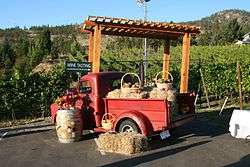Naramata, British Columbia
| Naramata | |
|---|---|
| Community | |
|
A wine tasting in Naramata wine country | |
 Naramata | |
| Coordinates: 49°35′N 119°35′W / 49.583°N 119.583°WCoordinates: 49°35′N 119°35′W / 49.583°N 119.583°W | |
| Country | Canada |
| Province | British Columbia |
| Regional District | Okanagan–Similkameen |
Naramata is a community of approximately 2000 people within the Regional District of Okanagan–Similkameen in British Columbia, Canada. Naramata is situated in the Okanagan Valley on the southeast shore of Okanagan Lake, to the north of Penticton from which is the only major road access. The town can also be accessed via the Chute Lake road from the northeast.
History
Founded in 1907 by John Moore Robinson as a prime agricultural area, Naramata was also known in its early years as a cultural centre. People from across the Okanagan would arrive by boat for concerts, plays, operas and regattas. Paddlewheelers regularly stopped at the local wharf carrying freight and passengers up and down Okanagan Lake. In 1914, Naramata received a new link with the rest of Canada when the Kettle Valley Railway was completed on the hillside above the village. Due to the intense volume of rock work it gained the reputation as one of the most difficult stretches of KVR construction. Today, remnants of the KVR make for great exploration, such as the train tunnels, rock ovens, and the railway right-of-way which clings to the hillside high above Okanagan Lake and is now part of the Trans-Canada Trail.
There are many fruit orchards in Naramata, peach, plum, pear, cherry, apricot and apple. Starting in the mid-nineties, there has been an acceleration in the growth of the wine industry in the area now known as the "Naramata Bench". The result has been a drastic decline in the relative economic importance of fruit growing, so much so that the Naramata fruit-packing facility (part of the Okanagan Tree Fruit Co-operative) has been closed (2009), and the remaining growers must ship their fruit to Penticton, or sell privately.
Economy
Agriculture and tourism form the economic base of the village of Naramata. The agricultural sector once mostly consisting of orchards is rapidly being supplanted by vineyards and wineries that are collectively referred to as the "Naramata Bench". Tourism is served by many motels, beach side resorts and a variety of bed and breakfast operations that cater to summertime visitors. The Centre at Naramata, a conference and educational centre of The United Church of Canada, was founded in 1947. [1][2]
Climate
| Climate data for Naramata | |||||||||||||
|---|---|---|---|---|---|---|---|---|---|---|---|---|---|
| Month | Jan | Feb | Mar | Apr | May | Jun | Jul | Aug | Sep | Oct | Nov | Dec | Year |
| Record high °C (°F) | 14.5 (58.1) |
16.5 (61.7) |
22 (72) |
29.5 (85.1) |
32.5 (90.5) |
36 (97) |
38.5 (101.3) |
37.5 (99.5) |
34.5 (94.1) |
25 (77) |
21 (70) |
11.5 (52.7) |
38.5 (101.3) |
| Average high °C (°F) | 1.2 (34.2) |
4.3 (39.7) |
10.2 (50.4) |
15.4 (59.7) |
20.1 (68.2) |
23.7 (74.7) |
27 (81) |
27.1 (80.8) |
21.7 (71.1) |
13.6 (56.5) |
6.6 (43.9) |
1.5 (34.7) |
14.4 (57.9) |
| Daily mean °C (°F) | −1.2 (29.8) |
1 (34) |
5.5 (41.9) |
9.8 (49.6) |
14 (57) |
17.6 (63.7) |
20.4 (68.7) |
20.4 (68.7) |
15.7 (60.3) |
9.3 (48.7) |
3.8 (38.8) |
−0.7 (30.7) |
9.6 (49.3) |
| Average low °C (°F) | −3.6 (25.5) |
−2.3 (27.9) |
0.8 (33.4) |
4.2 (39.6) |
7.9 (46.2) |
11.3 (52.3) |
13.6 (56.5) |
13.7 (56.7) |
9.7 (49.5) |
4.9 (40.8) |
0.9 (33.6) |
−2.9 (26.8) |
4.8 (40.6) |
| Record low °C (°F) | −21 (−6) |
−21 (−6) |
−13 (9) |
−6.1 (21) |
−0.6 (30.9) |
3 (37) |
5.6 (42.1) |
6 (43) |
−1.1 (30) |
−10 (14) |
−14.5 (5.9) |
−18.5 (−1.3) |
−21 (−6) |
| Average precipitation mm (inches) | 27.1 (1.067) |
20.4 (0.803) |
17.5 (0.689) |
26.3 (1.035) |
34.2 (1.346) |
43.3 (1.705) |
30.2 (1.189) |
25.1 (0.988) |
22 (0.87) |
22 (0.87) |
30.2 (1.189) |
31.7 (1.248) |
330 (12.99) |
| Source: Environment Canada[3] | |||||||||||||
See also
References
External links
| ||||||||||||||
| ||||||||||||||||||||||||||||||||||||||||

